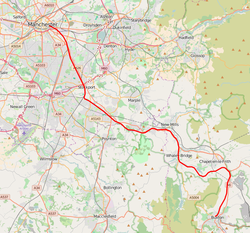Buxton line
| Buxton line | |||
|---|---|---|---|
|
Northern Rail Class 150 at Stockport railway station
|
|||
| Overview | |||
| System | National Rail | ||
| Status | Operational | ||
| Termini |
Manchester Piccadilly Buxton |
||
| Stations | 15 | ||
| Operation | |||
| Opened | 1860s | ||
| Owner | Network Rail | ||
| Operator(s) | Northern | ||
| Rolling stock | Class 142 (north of Hazel Grove only), Class 150, Class 156 | ||
| Technical | |||
| Line length | 19 miles (31 km) | ||
| Number of tracks | 2 | ||
| Track gauge | 1,435 mm (4 ft 8 1⁄2 in) standard gauge | ||
| Electrification | 25 kV 50 Hz AC (north of Hazel Grove only) | ||
| Operating speed | up to 100mph | ||
|
|||
The Buxton line is a railway line in Northern England, connecting Manchester with Buxton in Derbyshire. Passenger services on the line are currently operated by Northern.
It has its origins with the , which the LNWR built to connect with the Cromford and High Peak Railway at Whaley Bridge. In 1863, it built an extension from Whaley Bridge, via Chapel en le Frith to Buxton. This forestalled the Manchester, Sheffield and Lincolnshire Railway's plans for the area, and also the Midland Railway's attempts to reach Manchester.
The latter two railways were forced to combine forces in a line following the LNWR, but north of it, through New Mills (part of what is now known as the Hope Valley line), branching at Millers Dale. As a result, Buxton, one of the largest towns in the Peak, never achieved main line status.
The LNWR had offered the use of the line but, with its climb through Dove Holes, the Midland did not consider it useful for express trains, saying that it went up a steep hill merely for the sake of going down. The LNWR may have saved costs in construction but it proved difficult to operate, even with the powerful locomotives they had been forced to introduce for their lines north of Manchester. In later days, a seventeen-mile stretch was operated using banking engines, the longest such section on the British railway system. In 1957 there was a serious accident at Chapel-en-le-Frith in which driver John Axon, who died at his post attempting to control a runaway goods train, received the George Cross medal.
...
Wikipedia

